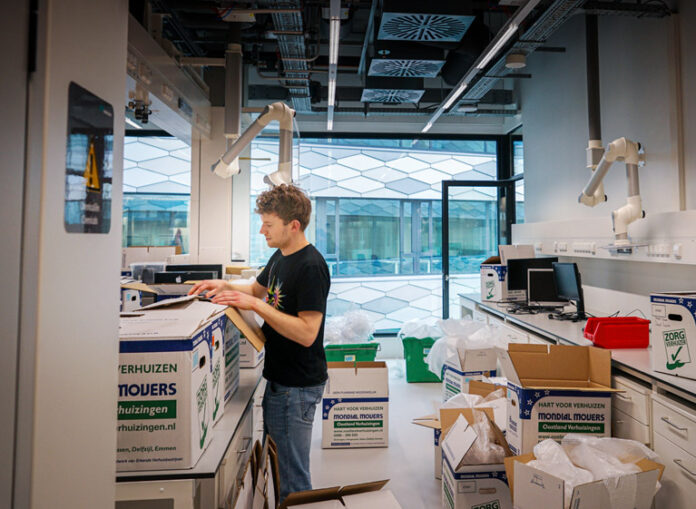Starting Monday, the fume hoods in two sections of the Feringa Building will be back in use. Research groups in sections 5615 and 5616 will be able to return to their new laboratories at that time.
‘We’re relieved’, says portfolio manager Esther Marije Klop. ‘But we still need to take care of the other sections.. A crucial factor has been that everyone on the team has worked incredibly hard over the past few weeks to get everything in order.’
According to Klop, it was particularly complicated to determine exactly what needed to be done to make the labs safe again and how to do that in the most practical way. ‘That puzzle has now been solved.’
The brand-new Feringa Building has faced major issues with its air management system and fume hoods since its completion. Just before the summer, it became clear that the safe operation of the fume hoods couldn’t be guaranteed, which meant they couldn’t be used in the laboratories.
However, the malfunctioning alarm system has now been redesigned and approved, and the air management system, along with most of the fume hoods, is functioning properly.
Still unresolved issues
Problems with negative pressure in some labs—which should prevent toxic substances from leaking into hallways in the event of an accident—are still unresolved. To ensure safe working conditions, the emergency response team can temporarily evacuate the entire section in case of an incident. A permanent solution is being worked on.
Researchers are happy with the progress. ‘My institute was hit hard, but now there is light at the end of the tunnel’, says Wesley Browne with the Stratingh Institute.
‘We can get back to work, and that’s a huge relief’, confirms Gerard Roelfes, the institute’s director.
Wait and see
Not everyone is rushing to move back. ‘There are still many issues to be resolved in the Feringa Building labs’, says PhD candidate Gianni Pacella from the Zernike Institute for Advanced Materials (ZIAM). ‘Nobody from my group is moving back yet because people simply don’t trust the management. They’re waiting a few weeks in the Nijenborgh 4 labs to see how things progress.’
For Pacella, the move comes too late. His contract ends next week, meaning he had to cancel his final experiments.
Elsewhere in the Feringa Building, progress is also being made. Alarm systems and gas pipes are functioning but still need further testing, and the air management system requires additional adjustments. ‘That’s the most time-consuming part, and it might take a few more weeks to complete the final floor’, Klop explains. ‘But we’ve urged the installation company to step up their efforts.’
Recognition of delays
While parts of ZIAM can now relocate, director Moniek Tromp still cannot move her own work. Yet, she remains optimistic. ‘Changes to the crisis team have helped’, she says. ‘Things are finally being addressed, and we’re discovering what was going right and what wasn’t, and that is good news.’
However, it’s important that researchers affected by the delays are not forgotten. ‘There needs to be some kind of recognition’, Tromp says. ‘And perhaps a bit more funding, so we can offer extensions and support people.’
Roelfes agrees. ‘The first priority is getting people back to work, also in the other sections. But after that, we need to look at how we can compensate the researchers—either financially or in other ways.’
Meanwhile, the faculty board is in discussion with the university’s board of directors to explore how it can assist in covering the costs of the delays. ‘But it’s too early to say what the outcome will be’, Klop says.




